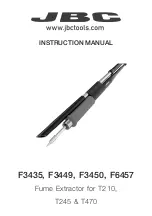
USE AND MAINTENANCE MANUAL
08812942(3)2004-05 A
13
SQUEEGEE CLEANING
1.
Drive the machine on a level ground.
2.
Check the switches (5 and 6, Fig. B) are in "0"
position.
3.
Lower the squeegee (10) using the lever (19, Fig. C).
4.
Disconnect the vacuum hose (26, Fig. C) from the
squeegee.
5.
Loosen the knobs (11, Fig. C) and remove the
squeegee (10).
6.
Wash and clean the squeegee; in particular, clean the
compartments (1, Fig. D) and the hole (2) from dirt
and debris. Check that the front (3) and rear blades
(4) are integral and free from cuts and tears;
otherwise replace them (see the procedure in the
following paragraph).
7.
Install in the reverse order of removal.
SQUEEGEE BLADE CHECK (AND
REPLACEMENT)
1.
Clean the squeegee (as described in the previous
paragraph).
2.
Check that the edges (5, Fig. D) of the front and rear
blades (12) lay down on the same level, along all their
length; otherwise adjust their height as described
below:
– Disengage the retainer (6) and loosen the wing
nuts (7) to adjust the rear blade (4); then tighten
the wing nuts and engage the retainer;
– Loosen the nuts (8) to adjust the front blade (3);
then tighten the nuts.
3.
Check that the front and rear blades (3 and 4) are
integral and free from cuts and lacerations; otherwise
replace them as described below. Check that the front
corner (9) of the rear blade is not worn; otherwise,
overturn the blade to replace the worn corner with an
integral one. If the other corners are worn too, replace
the blade as described below:
– To replace (or overturn) the rear blade (4)
disengage the retainer (6), unscrew the wing nuts
(7) and the retaining strip (10). Install in the
reverse order of removal;
– To replace the front blade (3) remove the nuts (8)
and the retaining strip (11). Install in the reverse
order of removal.
After the blade replacement (or overturning),
adjust their height as described at the previous
step.
4.
Reinstall the squeegee assembly (10, Fig. C) in the
correct position and screw down the knobs (11).
5.
Connect the vacuum hose (26, Fig. C) to the
squeegee (10).
6.
If necessary, adjust the balance adjusting knob (12,
Fig. C) of the squeegee.
BRUSH CLEANING
1.
Remove the brush, as described in the Use chapter.
2.
Clean and wash the brush with water and solution.
3.
Check that the brush bristles are integral and not
excessively worn, otherwise replace the brush.
TANK AND VACUUM GRID WITH FLOAT
CLEANING
1.
Push the machine to the appointed disposal area.
2.
Check the switches (5 and 6, Fig. B) are in "0"
position.
3.
Lift the cover (2, Fig. H), clean and wash with clean
water the cover (4, Fig. E), the tanks (5 and 6) and the
screen (1) of the vacuum automatic closing.
Drain the water from the tanks using the hoses (17
and 18, Fig. C).
4.
If necessary, release the retainers (2, Fig. E) and
open the screen (1); recover the float (3), clean all the
components and then reinstall them.
5.
Check that the tank cover gasket (7) is integral.
If necessary replace the gasket (7) after removing it
from its housing (8). When assembling the new
gasket, install its joint (9) in the (central) area as
shown in the figure.
6.
Check that the gasket (7) bearing surface (10) is
integral and adequate for the seal of the gasket itself.
7.
Check that the compensation hole (11, Fig. E) is not
obstructed.
8.
Close the cover (4, Fig. E).
NOTE
The squeegee must be clean and its blades
must be in good conditions in order to get a
good drying.
CAUTION!
It is advisable to use protective gloves when
cleaning the squeegee because there can be
cutting debris.
CAUTION!
It is advisable to use protective gloves when
cleaning the brush because there can be
cutting debris.
NOTE
The gasket (7) creates vacuum in the tank for
the recovery water vacuuming.
NOTE
The hole (11, Fig. E) contributes to create
vacuum in the tank because it allows the
compensation of the air in the cover
interspace.
















































